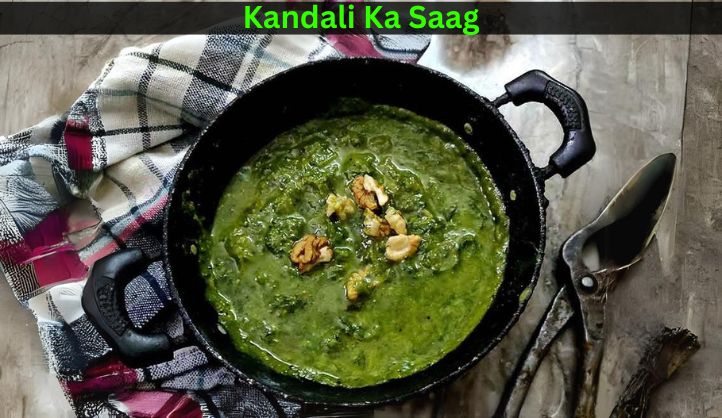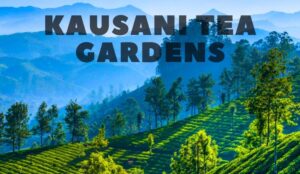Nestled in the foothills of the Himalayas lies a unique culinary tradition. Here, in the state of Uttarakhand, India, a special leafy green dish thrives – Kandali ka Saag. This dish, also known as Sisunak Saag or Bichu Ghas ka Saag, translates to “Stinging Nettle Leaves.” Yes, you read that right! Kandali, the star ingredient, is a wild herb with tiny stinging hairs.
Kandali leaves are rich in vitamins and minerals, making Kandali ka Saag a nutritious dish. The leaves are cooked down to a pulp, often flavored with spices like cumin, coriander, and turmeric. Some variations incorporate chopped tomatoes or lentils for added texture. The result is a flavorful and earthy green curry, perfect with rice or roti.
The unique aspect of Kandali ka Saag goes beyond its taste. Foraging for the leaves is a traditional practice, that connects people to the land. The preparation process itself is an art form, passed down through generations. Enjoying a plate of Kandali ka Saag is more than just a meal; it’s a cultural experience.
Kandali ka saag is a seasonal dish
There’s a local saying, “Kandali khaaye, vayu bhagaye” which translates to “Eating Kandali drives away ailments.”
Kandali leaves are also used for medicinal purposes, believed to aid digestion and reduce inflammation.
So, next time you’re looking for an adventurous culinary experience, consider Kandali ka Saag. Just remember to let the experts handle the harvesting.
Some Other Dishes of Uttarakhand
Sure, here are some other dishes of Uttarakhand.
-
Kafuli/Kaapa: This dish is considered the most popular food in Uttarakhand and is a staple in Pahari cuisine. Made with spinach, lai (mustard greens), and fenugreek leaves, Kafuli is a delicious, light, and healthy curry. It is cooked in an iron kadhai (wok) and eaten with gravy made from rice or wheat paste and water. Kafuli is a winter dish, as mustard greens and fenugreek are at their seasonal best during this time.
-
Bhang Ki Chutney: Bhang Ki Chutney is a unique and flavorful accompaniment to many dishes in Uttarakhand. Bhang, also known as cannabis, is used in its seed form and adds a nutty, earthy taste to the chutney. Along with bhang seeds, the chutney is made with coriander leaves, mint leaves, chilies, and spices.
-
Phaanu: This protein-rich dish is a staple in Garhwali cuisine. Made with black gram lentil paste (black urad dal) and rajma (kidney beans), Phaanu is slow-cooked with a blend of spices, resulting in a thick and flavorful curry. It is often served with rice or roti.
-
Baadi: Another protein-rich dish from the Garhwal region, Baadi is made with lentils like ghat (moth beans) or bhatt (black gram) that are ground into a paste. The paste is then steamed in leaves and shaped into patties. Baadi can be enjoyed on its own or stir-fried with vegetables.
-
Aloo Ka Jhol: This simple yet flavorful dish is a comfort food in many households of Uttarakhand. Made with potatoes (aloo), tomatoes (tamatar), and a basic spice blend, Aloo Ka Jhol is a quick and easy curry perfect for a weeknight meal. It is typically served with rice or roti.
-
Chainsoo: This stir-fried dish is a specialty of the Kumaon region. Made with colocasia leaves (also known as taro leaves), Chainsoo is a flavorful and healthy side dish. The colocasia leaves are stir-fried with spices and sometimes include other vegetables like potatoes or green beans.
-
Meetha Bhaat: This dish is a common sight during festivals and celebrations, bringing a touch of sweetness to joyous occasions. But its simple preparation also makes it a perfect way to end a hearty meal. Served warm or at room temperature, Meetha Bhaat is a satisfying and soul-warming treat.
-
Jhangora Ki Kheer: No meal is complete without dessert, and Jhangora Ki Kheer is a delicious and nutritious option from Uttarakhand. Made with jhangora (barnyard millet), a grain indigenous to the high altitudes of the state, this kheer is cooked with milk, sugar, and nuts. The result is a creamy and flavorful pudding that is perfect for satisfying your sweet tooth.
Kandali ka Saag – A Mountain Treat with a Sting
Kandali ka Saag may be a hidden gem in the culinary world, but its main ingredient, stinging nettle, is a surprisingly widespread plant. Found across Europe, Asia, and North America, stinging nettle boasts a long history as a food source and medicine. Similar dishes utilizing nettle leaves exist in various cultures, each with its unique twist. In Italy, for example, nettle is used in pasta dishes and risotto. The British have a tradition of nettle tea, believed to have detoxifying properties.
The Thrill of the Harvest
Foraging for Kandali leaves is a cherished tradition in the villages of Uttarakhand. Villagers venture into the hills, armed with gloves and knowledge of where to find the best patches. The young, tender shoots are the most prized, offering the best flavor and minimal stinging. The experience is a testament to the deep connection these communities have with their environment.
From Stinging to Savory
The key to transforming this prickly plant into a delectable dish lies in the preparation.
- Glove Up: Harvesters wear thick gloves to protect themselves from the stinging hairs.
- Selective Picking: Only the young, tender leaves are chosen, minimizing the sting potential.
- Blanching and Washing: The leaves are quickly blanched in boiling water to deactivate the stinging mechanism. They are then washed thoroughly to remove any remaining irritants.
- The Culinary Dance: The blanched leaves are cooked down to a pulp, often with the addition of chopped onions, tomatoes, and a blend of warming spices like cumin, coriander, and turmeric. Some variations incorporate lentils or chopped spinach for added texture and protein.
- Flavor and Health Benefits: The final dish is a vibrant green curry with an earthy, slightly bitter flavor. The bitterness is often balanced with a touch of sweetness from tomatoes or a squeeze of lemon. Kandali ka Saag is not just delicious; it’s also a powerhouse of nutrients. The leaves are rich in vitamins A, C, and K, as well as iron and calcium. They are also believed to have anti-inflammatory properties.
A Celebration of Culture and Cuisine
Enjoying Kandali ka Saag is more than just a meal. It’s a chance to experience the rich cultural heritage of the Garhwal and Kumaon regions of Uttarakhand. It’s a testament to the resourcefulness and resilience of mountain communities. So, the next time you encounter Kandali ka Saag on a menu, take a leap of faith and embrace this unique and flavorful dish. You might just discover your new favorite Himalayan treasure.
FAQs About Kandali ka Saag
1. What is Kandali ka Saag?
Kandali ka Saag, also known as Sisunak Saag or Bichu Ghas ka Saag, is a traditional dish from Uttarakhand, India. It’s a green curry made with the leaves of the stinging nettle plant (Kandali).
2. Does Kandali ka Saag sting?
Yes, the raw leaves of the stinging nettle plant contain tiny hairs that can cause a stinging sensation. However, the stinging mechanism is deactivated through blanching in boiling water during preparation, making the cooked dish safe to eat.
3. What does Kandali ka Saag taste like?
Kandali ka Saag has an earthy, slightly bitter flavor that is often balanced with a touch of sweetness from tomatoes or a squeeze of lemon. The spices like cumin, coriander, and turmeric add a warm touch.
4. What are the health benefits of Kandali ka Saag?
Kandali leaves are rich in vitamins A, C, and K, as well as iron and calcium. They are also believed to have anti-inflammatory properties.
5. How is Kandali ka Saag typically served?
Kandali ka Saag is traditionally served with rice or roti (flatbread).





